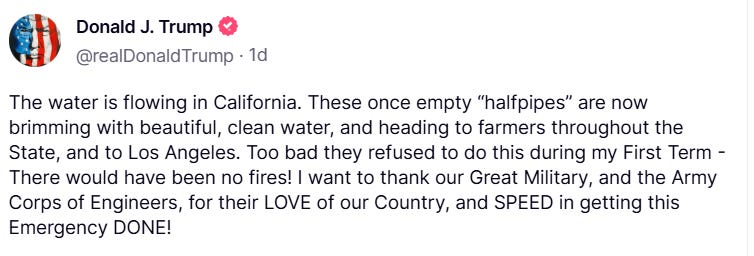
I am sure by now that you heard about the water President Trump ordered federal agencies to flow in California. I researched it, so I can keep you all informed. I also use my knowledge as a lifelong, seventh-generation resident of California’s rural Fresno County on my paternal grandfather’s side.
President Trump proclaimed on Truth Social that the U.S. military entered California and “the water is flowing.” He referenced the executive order he issued on January 24 directing the Commerce Secretary and the Interior Secretary to release water in California from the federal Central Valley Project and the state-run State Water Project.
The executive order specifically ordered the Bureau of Reclamation, which operates under the Interior Secretary, “to deliver more water…to high needs communities.” Last week, the federal government released water from the Terminus Dam at Lake Kaweah and the Schafer Dam at Schafer Lake, which supplies water to farmers and cities in the San Joaquin Valley. More than two billion gallons of water flowed into the reservoirs, according to recent estimates. The water flowing into the two dams does not reach Southern California.
“There is, of course, no way to get it to Los Angeles,” said water scientist Peter Gleick.
Water managers told SJV Water that they only received an “hour’s warning” from the U.S. Army Corp’s office in Sacramento that the water release would cause the Tule and Kaweah rivers to be at “channel capacity” by the evening of January 24. The maximum capacity for the Kaweah River is 5,500 cubic feet per second (cfs), and for the Tule River, it is 3,500 cfs.
SJV Water reported that “those levels were last seen” during the floods in 2023, which destroyed homes and businesses while damaging infrastructure. Local water managers managed to get the Army Corps to release less water on January 24 and increase it the next day.
No Advance Notice For Farmers
Farmers usually get a 10-day heads up when water will be released from the dams. House Representative Jim Costa (CA-21), a senior member of the House Agriculture Committee, wrote a letter to Defense Secretary, Pete Hegseth, about the unplanned water releases from Terminus Dam and Success Lake in Tulare County.
Constituents, including farmers and water managers, told Costa they received “little notice” about the water releases. That volume of water could quickly overwhelm and even flood downstream communities, he wrote. He urged Secretary Hegseth “to engage with federal, state, and local officials.”
A Fresno news station reported that “South Valley farmers weren’t happy to see the outward flow” from the dams because that water is “their spring and summer supply and irrigating crops.”
Winter is not the time of year when farmers irrigate crops, as it is the rainy season in the San Joaquin Valley. Summer is when irrigation is badly needed because the area has a long dry season then. Last summer, it reached a high of 116 degrees Fahrenheit in Fresno with four percent humidity.
LA Officials Respond To Misinformation About the Wildfires
The Los Angeles Department of Water and Power (DWP) released a statement about the wildfires that ripped through the area. The DWP stated that its “crews and our system were prepared, but overwhelmed by the massive demand as firefighting continued.”
The LA agency also clarified that the fire hydrates in the Pacific Palisades worked before the fire, and pump stations did not lose power during the fire. The system lost water pressure “due to unprecedented and extreme water demand to fight the wildfire without aerial support.”
The reason that air support was minimal to none at times during the wildfire was due to Santa Ana winds. As a lifelong California resident, I can attest to the warmth of the winds that the northern half of the state calls mono winds. Those winds blowing at hurricane force in areas with steep canyons make it impossible for planes to help fight wildfires.
The DWP provided “deployed potable water tankers to sustain support for firefighting efforts” when it “identified the risk of losing water in the tanks and water pressure in the system.” The agency also took the Santa Ynez Reservoir out of service before the wildfires started for routine maintenance.
Consider upgrading your subscription so I can keep the newsletter going and expand it.





